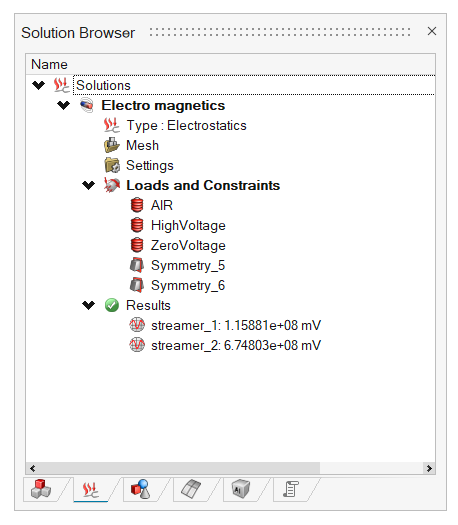Streamer Criterion
Introduction
Streamer Criterion is available in 3D Electrostatic solution.
Physical phenomena
The streamer is a phenomenon that occurs just before the full breakdown. Ionized and conductive canals appear and spread in the dielectric gas. Initially, a first electron is accelerated by the electric field, and enters in collision with the surrounding gas molecules and atoms, with enough energy to ionize them. New electrons are generated, and then they are accelerated again by the field, creating also new ionized canals. This can be seen as a chain reaction: the electronic avalanche process.
The streamer criterion do not intend to be a complete simulation of the breakdown process in gases, it is only a criteria that is applied on the field obtained by an electrostatic simulation (i.e. the background field, before any discharge phenomena occurrence).
This criterion gives an estimation of the threshold voltage that can trigger the electronic avalanche process leading to an electrical breakdown in the gas. This voltage is called “Streamer inception voltage”.
Mathematical model
The principle of the streamer criterion is based on the integration of the effective ionization coefficient (alpha_eff) of the considered gas, along the most probable path for the breakdown, between the two electrical contacts. These contacts are energized at different electrical potentials (typically one contact is energized at high voltage, the other one is earthed). The Streamer path is approximated by electric field lines.
The effective ionization coefficient aeff is defined by a mathematical formula obtained by fitting experimental curves (in general, polynomial function). Therefore, the curves are valid only in the experimental conditions and in a defined field range chosen for the fitting. In the literature, several mathematical formula exist for a same gas. User has to choose the formula adapted to his device.
The criterion is given by the formula:
Where:
α eff it the effective ionization coefficient of the gas
x is the coordinate on the critical path
K is the ionization content. A common value of K is 18.
- For the Air:
- For the SF6:
- For Er<12.36kV/mm/bar:
- For Er>12.36kV/mm/bar:
With :
P the pressure in bar
Er = Mod(E) / P
Valid(Er,2.0) allows considering αeff as equal to zero for all Er values under 2kV/mm/bar. In fact, positive αeff for those low E values should not be taken into account in the integration (for negative αeff values, it is automatically set to zero)
- For Er<12.36kV/mm/bar:
Bisection method
As the law between the electric field and the electric potential is linear, a bisection method is applied on the electric field until K is equal to the threshold. It allows finding the Streamer inception voltage on the considered path.
How to use Streamer Criterion tool
Here is the Streamer Criterion interface:
- Select Streamer origin. For now, only Face is available
- Select the dielectric Gas characteristics between:
- Air model
- SF6 model
- Enter the dielectric gas Pressure value in bar.
- Enter the Streamer threshold value (no units). It correponds to the ionization content K described in Mathematical model and Bisection method. A common value of K is 18.
- Select the Region of propagation corresponding to the dielectric gas by selecting the body.
- Optionnal: Modify Advanced options if necessary
- Select the Streamer starting face(s). Usually it corresponds to the faces of
the high voltage bodies.Note: If user doesn't know if Streamers start from high voltage or low voltage bodies, it is possible to set in the Advanced options the Integration mode option to Integration starting from both sides of path (the computation will take more time in this case).
- Click on the
to create the Streamer computation entity.
A new Streamer computation entity is created with the Status N/A
Note: Click on the garbage iconto delete Streamer computation entity
- It is possible to create several Streamer computation entities by following the steps 1 to 8
- Launch the Streamer computation by clicking on Create
Streamlines
The Streamer computation entities contain now results and the Status becomes Available.
The Streamer results are now visible. The most critical path (having the lowest Streamer inception voltage) is represented by a red arrow. Black paths can be displayed: their Streamer inception voltage are higher than critical path inception voltage and lower than the voltage applied in the simulation. Here is an example of results:
It is possible to check the option Display only the most probable streamer to see only the most critical path
The Streamer inception voltage value associated to the red arrow is available in the Results in the Solution tab of the data tree. Here is an example:
 Note: It is possible to delete Streamer computation entity results by clicking on Delete Streamlines. The computation can be launched again.
Note: It is possible to delete Streamer computation entity results by clicking on Delete Streamlines. The computation can be launched again.
Advices
- When using Surface mesh and Tet mesh to mesh the device, in order to have conform mesh, please check the option Create matching mesh (Parasolid)
- If the device contains a periodicity, the mesh should be identical on both periodicity planes. For that, create symmetry mesh control. Please see Symmetry Mesh Control documentation.
- To define a dielectric media: If it is not the Air, Create a material with
dielectric property:
- Create material.
- Choose the Class as Dielectric.
- Enter either scalar permittivity value or tabulated data of the electric field depending on the electric flux density.
Limitation
Streamer Criterion may not work properly on some cases: the selected faces for Streamers starting may not be correctly taken into account.
That can lead to wrong Streamers starting faces or a Streamer computation failure.
In such cases, please open the solved model in Flux (Right-click on ) and run the Streamer computation.